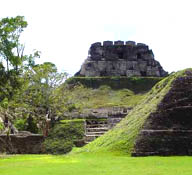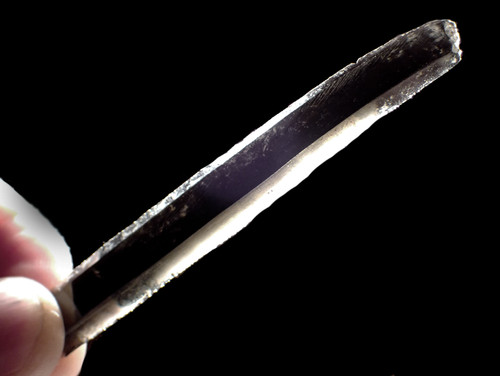Product Description
For discriminating collectors of rare Mayan ceremonial objects, this is a LARGE and INTACT ceramic ritual urn depicting the RAIN GOD Chaac (later Tlaloc to the Aztecs). On a scale of 1 to 10 for impressiveness, this piece is a 20! It possesses an incredible energy and sense of "presence" with its bulging eyes, grotesque features, spiked surface and immense proportions. It is one of the most impressive Mayan vessels we have ever offered and one of the largest! More amazing is the fact that unlike most large ancient vessels, this example is UNBROKEN AND COMPLETE! Pieces of this magnitude have proven themselves in major auctions, to be top investment performers, forever increasing in value due to their extreme scarcity in the public market.
This large urn features a pronounced head of the Mayan rain god Chaac, one of oldest and most important gods of the culture. With his lightning axe, Chaac strikes the clouds and produces thunder and rain. Of immense size, this ceramic shows the god wearing earspools and with spikes around the sides of the head. The thorn-like projections on the sides represent the thorns of a young ceiba (kapok) tree - considered the "Tree of Life" by the Mayans. Its trunk connected the living world with the underworld and the stars above. The ceiba was the most sacred tree for the ancient Maya, and according to Maya mythology, it was the symbol of the universe. The tree signified a route of communication between the three levels of earth. Its roots were said to reach down into the underworld, its trunk represented the middle world where the humans live, and its canopy of branches arched high in the sky symbolized the upper world and the thirteen levels in which the Maya heaven was divided. Pottery featuring the thorns on the trunk of a young tree would signify the vessel's use and purpose in religious ceremonies.
This rain deity worship focused heavily on human sacrifice. Among the Mayan rituals for Chaac in the request of rain is a ceremonial banquet. It included four boys (one for each cardinal point) acting and chanting as frogs. Not too long ago it was discovered that the sacrificial victims offered to Chaac by the Mayans were young boys, rather than virgin girls as previously thought. It has also been speculated that since Chaac was believed to have been helped by four dwarfs, children were this deity’s preferred offering. .
The cult of Tlaloc is one of the oldest and most universal in ancient Mexico to the Aztecs, later adopting the Mayan Chaac rain god into their worship of Tlaloc. Tlaloc, associated with mountaintop shrines and with life-giving rain, is as at least as old as Teotihuacan. An underground Tlaloc shrine has been found at Teotihuacan. Aztec rain god rituals to Tlaloc included ceremonies at the cenotes. Young men and women were lowered into these wells and left to drown there, so as to make them enter the realm (and possibly, become the escorts) of the rain deities. Alternatively, they were thrown into the wells later to be drawn up again, and give oracles (if they survived). The main rituals to Tlaloc though, involved the sacrifice of children on sacred mountaintops, like Mount Tlaloc. The children were beautifully adorned, dressed in the style of Tlaloc. The children to be sacrificed were cared to Mount Tlaloc on litters strewn with flowers and feathers, whilst also being surrounded by dancers. Once at the shrine, the children's hearts would be pulled out by priests. If, on the way to the shrine, these children cried, their tears were viewed as positive signs of imminent and abundant rains. The children were either slaves or the second-born children of noble people.
This urn was originally found INTACT and remarkably, has NO REPAIR OR FABRICATION. Its robust construction most likely protected it over the ages. Traces of pigment can be seen with mineral deposits on surfaces and in crevices, attesting to its authenticity and un-restored nature.
An opportunity like this is a once-in-a-lifetime chance and anyone wishing to acquire a truly special piece should take note.
With our highest recommendations for fanciers of the magnificence of the Pre-Columbian cultures of ancient Central America. Includes our written unconditional lifetime certificate of GUARANTEED AUTHENTICITY. This is a very unusual example of Mayan art and ritual in ceramic.
Of all the ancient cultures of the Americas, no civilization has held more intrigue and secrets for so long as that of the Mayans. In 1960, their language code of glyphs was finally deciphered and forever changed our view of what we initially thought was a peaceful and harmonious society. On the contrary, the Mayan Culture of the latter years was bathed in the blood of vicious warfare and astounding levels of human sacrifice. Their technology was so advanced it is no wonder many believe they received intelligence from extra-terrestrials. Despite our recent discoveries of Mayan mathematics, astronomy and calendar technology, the Mayans still leave us with many mysteries. Their love of war caused them to manufacture spectacular weapons with inherent beauty and artistry. Their ceramics depict a fascinating culture of status, sacrifice and deep religious devotion to a number of strange gods.
All surfaces exhibit impacted sediment and mineral patina deep in microscopic crevices - traits ONLY seen in AUTHENTIC SPECIMENS.
 Of all the ancient cultures of the Americas, no civilization has held more intrigue and secrets for so long as that of the Mayans. In 1960, their language code of glyphs was finally deciphered and forever changed our view of what we initially thought was a peaceful and harmonious society. On the contrary, the Mayan Culture of the latter years was bathed in the blood of vicious warfare and astounding levels of human sacrifice. Their technology was so advanced it is no wonder many believe they received intelligence from extra-terrestrials. Despite our recent discoveries of Mayan mathematics, astronomy and calendar technology, the Mayans still leave us with many mysteries. Their love of war caused them to manufacture spectacular weapons with inherent beauty and artistry. Their ceramics depict a fascinating culture of status, sacrifice and deep religious devotion to a number of strange gods.
Of all the ancient cultures of the Americas, no civilization has held more intrigue and secrets for so long as that of the Mayans. In 1960, their language code of glyphs was finally deciphered and forever changed our view of what we initially thought was a peaceful and harmonious society. On the contrary, the Mayan Culture of the latter years was bathed in the blood of vicious warfare and astounding levels of human sacrifice. Their technology was so advanced it is no wonder many believe they received intelligence from extra-terrestrials. Despite our recent discoveries of Mayan mathematics, astronomy and calendar technology, the Mayans still leave us with many mysteries. Their love of war caused them to manufacture spectacular weapons with inherent beauty and artistry. Their ceramics depict a fascinating culture of status, sacrifice and deep religious devotion to a number of strange gods.
Archaeologists divide the Mayan Culture into different periods - LATE PRE-CLASSIC / PROTO-CLASSIC (300 BC - 300 AD), EARLY CLASSIC (300 AD - 600 AD), LATE CLASSIC (600 AD - 830 AD), TERMINAL CLASSIC (830 AD - 950 AD). The earliest days of the Maya date back to 2000 BC when small farming villages first appeared in the highlands and Pacific coastline of Guatemala. Crops such as corn, squash and beans made up the staple of their diet and are believed to have been brought from previous migration through Mexico. The Maya pottery styles were unique to the early Maya settlements, though. By 1000 BC, villages sprang up in the lowland regions. The Maya lived in the same locations for centuries and in a continuous state of architectural improvement and expansion leading up to the magnificent 'super-cities' we associate with them today. By 300 AD. full-scale cities were being built with stone featuring massive plazas, temples and pyramids reaching 20 stories high.
It is no wonder that some believe that extra-terrestrial beings brought their knowledge to the Maya. By 300 AD, the first inscriptions suddenly appeared in Maya sites. These early inscriptions were so beautiful it was as if the gods had delivered it to the Mayan themselves! Forward to 600 years later and the inscriptions cease. The first comprehensive writing system in Pre-Columbian America was invented by the Maya. Among the mysteries of the Maya are their amazing understanding of astronomy along with the development of an accurate calendar and mathematical system. Their number system was based on units of 20 and included a concept of 'zero'.
The skills of the Mayan craft are exemplified in their stone and wood carvings, flaked stone objects, pottery and personal adornment. Much of their art centers around their devotion to a religion that is both fascinating and gory. Blood-letting rituals were the norm and many acts of war were motivated by the capture of vast numbers of their enemies for ritual human sacrifice that would run for days on end, forming lakes of blood and fat at the bases of their stone pyramids that defy architectural explanation.
Our understanding of the fascinating MAYAN CULTURE was completely wrong and misinterpreted until as recent as the 1960, when major achievements were made in the deciphering of their glyph language. Elaborately designed ceremonial cities lacking any obvious defenses initially led us to believe that the Mayans were a peaceful theocracy living in ideal harmony with their environment and each other. We could not have been further from the truth. Lowland city-states lived in constant warfare with one another and the thirst of their gods for human blood and sacrifice seemed impossible to satiate.
Perhaps a lesson for us today, recent scientific analysis of the demise of the highly advanced Mayan civilization now answers the biggest mystery of all - "What ever happened to the ancient Mayans?". Long-term high population density (500 people per square mile - the highest in the world at the time) of unbelievable proportions put a strain on their agricultural system that was impossible to sustain. The effects of nutritional deficiencies are evident in bone and tooth analysis on graves dating to the Late Classic Period. It is most probable that starvation put unbearable sociopolitical stress on the society to either kill each other for food or die of hunger necessitated by the technological advancement of warfare and its escalation.
 US DOLLAR
US DOLLAR
 EURO
EURO
 AUSTRALIAN DOLLAR
AUSTRALIAN DOLLAR
 CANADIAN DOLLAR
CANADIAN DOLLAR
 POUND STERLING
POUND STERLING




























